ISSN ONLINE(2319-8753)PRINT(2347-6710)
ISSN ONLINE(2319-8753)PRINT(2347-6710)
K,Saravanan 1, B.Janarthanan 2
|
| Related article at Pubmed, Scholar Google |
Visit for more related articles at International Journal of Innovative Research in Science, Engineering and Technology
This study has been made to analyze the exergy and energy assessment of double exposure solar cooker (DESC) under local climatic condition in Coimbatore, Tamilnadu, India. Cooking test of food stuffs has been done with vessels viz., copper, aluminium, stainless steel and ceramic pots. Energy balance equations have been written for the temperature elements of the cooker . It has been found that the copper vessel has significant impact on the performance of the cooker and the theoretical and experimental observations are in good agreement.Exergy and Energy assesment of the cooker was also carried out.
Keywords |
| Energy,Exergy,Double exposure ,Box-type solar cooker,Efficiency,Absorber plate. |
INTRODUCTION |
| The effective method of utilizing solar energy to meet the demand for cooking can be achieved by solar cooking. Many countries have utilized solar energy for cooking rice, vegetables, meat etc., by using different designs of solar cookers. Researchers around the world have made attempts to analysis the performance of various designs of cookers in different locations. |
LITERATURE SURVEY |
| Energy and exergy efficiency comparison of community-size (CSC) and domestic-size paraboloidal solar cooker(DSC) performance by S.C. Kaushik et al. [1]. It is found that the CSC provides high performance, which is indicated by high energy efficiency, exergy efficiency and low characteristic boiling time in comparison with the DSC. Pandey et al. [3] paraboloid type and box type have been evaluated using exergy analysis. It is found that the exergy efficiency vary with the cooking stuff. Panwar et al. [4] has been made energy and exergy analysis of a domestic size parabolic solar cooker. It is found that maximum energy and exergy efficiencies of the cooker were experimentally evaluated, and it is about 46.82% and 32.97%, respectively. Negi et al. [13] design a box type solar cooker utilizing non-tracking concentrator optics to enhance the solar energy availability inside the box for efficient cooking. It was confirmed that the cooker provided the increased heat collection and faster cooking compared with that of the conventional box type solar cooker. |
| Hasan simply designed and the low cost parabolic type solar cooker and evaluated the energy and exergy efficiencies of the cooker. Over all exergy output is 2.9-6.6W.Ozturk [6] has been made energy and exergy for solar box and parabolic cookers. It is found that energy and exergy efficiency for the box type solar cooker and parabolic solar cooker was in the range 3.05–35.2%, 0.58–3.52% and 2.79–15.65%, 0.4–1.25% during the experimental period. Ozturk [7] have been made energy and exergy efficiencies of a solar box-cooker and the average daily energy and exergy efficiencies of the box type solar cooker are 18.3 and 2.2%, respectively |
| Exergy based analysis on solar cookers by Naveen Kumar et al.[2]. It is found that the exergy power output and exergy power lost with temperature difference for different loads/mass of water for solar box type cooker and the four different parameters, use for exergy based test protocol for solar cookers. The experimental results had shown that the late evening cooking was possible due to the three reflectors which enhanced the incident solar radiation. Amer [14] carried out the theoretical and experimental assessment of a double exposure solar cooker with reflector and concluded that the cooking time was reduced by 30-60 min compared with that of the conventional box type solar cooker. |
| Sebaii and Ibrahim [12] have constructed box type solar cooker with one (model I) and four (model II)cooking pots in Tanta and evaluated the figure of merit F1 and F2. It has been confirmed that the cooking power P obtained is in agreement with the International standard test procedure for solar cookers. Funk [17] has proposed international standard for testing solar cookers and the procedure has been applied for historical solar cooker test data for proving as a useful tool for evaluating the relative performance of different designs of solar cookers. |
| Sunita Mahavar [19] designed a Single family solar cooker and its thermal and cooking performance F1 and F2.Mahavar et al. [15] have fabricated two novel cookers for the cooking requirements of small families and are small family solar cookers(SFSC-I), small family solar cookers(SFSC-II). The essential values of first figure of merit (F2) and second figure of merit(F2) and standard and cooking power suggested by Indian standard and International standard for box-type solar cookers has been evaluated and presented. |
| Further, Schwarzer et al. [16] discussed the basic characteristics and experimental procedures of general types of solar cookers. A simple analytical model was also presented by them, to design a simple cooking system with an optimum design parameter. A solar cooker with phase change material and three reflectors was designed and analysed by Buddhi et al. . Further, many researchers have been presented the energy and exergy efficiency of the box type and parabolic solar cookers (S. C. Kaushik et al. [1],[5], T.C. Kandpal et al. [19]). |
| In the present work an attempt has been made to propose and simulate the double exposure box type solar cooker. The analytical solutions for the temperature elements of the proposed cooker are developed by energy and exergy and temperature components of the cooker. |
DESCRIPTION OF DOUBLE EXPOSURE SOLAR COOKER |
| The photograph, schematic diagram and sectional view of the DESC are shown in the Figs. 1, 2 and 3. DESC consists of a rectangular box of inner and outer enclosure of dimensions 0.52 x 0.84 x 0.30 m and 0.44 x 0.75 x 0.30 m made of plywood. Glass wool insulation has been filled in the gap between the enclosures to trap the solar radiation within the cooker. Commercially available .005 m thick copper plate (0.35 x 0.60 m) was used as the absorber plate and painted black to absorb maximum amount of solar radiation. It has been fixed at a distance of 0.15 m from the top and bottom edge of the box. The inner sides of the cooker on either side of the absorber plate are provided with reflectors with an inclination of 30° with respect to the absorber plate. The glass cover of thickness 0.004 m has been used to cover the top and bottom side of the cooker. The lid of the cooker has a rectangular shape of dimension of 0.45 × 0.85 m and fixed at the top side of the cooker. |
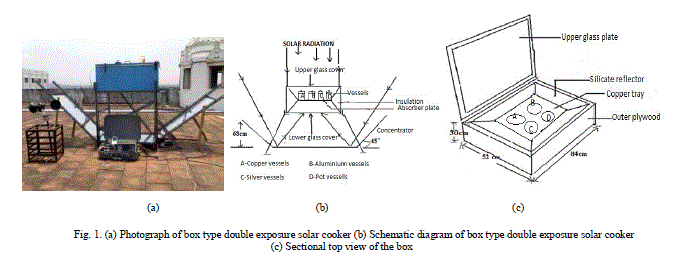 |
| Cooking vessels made of stainless steel, aluminum, ceramic pot and copper with diameter of 0.15 m and depth of 0.10 m has been used for cooking different food materials. The base of the vessels have been selected in a way to have good thermal contact with the absorber plate. The cooker is made air tight with the help of silicone sealant. Reflectors are fixed at an angle of 45° at the bottom on either sides of the cooker to reflect the radiation towards the absorber plate through the bottom. Another reflector has been fixed at a distance of 0.80 m beneath the bottom surface of the cooker. |
INSTRUMENTATION AND MEASUREMENTS |
| To analyze the energy and exergy assessment of the proposed cooker, experiments have been conducted in Department of Physics, Karpagam University, Coimbatore (11ºN latitude and 76º56’E longitude), Tamilnadu, India during April to October 2013. Observations for one of the typical experimental days have been used for the evaluation of the different parameters for the performance of the proposed cooker. Calibrated Copper-Constantan thermocouples have been used to measure the temperature elements of the cooker and cooking fluid. Solar radiation monitor and digital thermometers have been used to measure the total solar radiation and ambient temperature. |
ANALYSIS OF ENERGY AND EXERGY IN DESC |
| EXERGY ANALYSIS |
| The maximum degradation of energy in the locations of proposed cooker can be found by analysing the exergy input and output. Moreover the actual measurement of the performance of the system is found by using the concept of exergy. For available energy flux of radiation inside the cooker, exergy input to the solar cooker can be found by using the equation derived by Petela [23] |
 |
| different food stuffs in different days by using the cooker during the working hours of the day in both summer and winter months. The intensity of solar radiation and ambient temperature has been recorded for the experimental days with solar radiation monitor and digital thermometer. Among the experimental days in winter and summer, observations of the typical days have been considered for the exergy and energy analysis of the cooker with different cooking vessels in the cooker. Figure. 2 shows the variation of solar radiation and ambient temperature for one of the typical days in winter and it is observed that the intensity of solar radiation gradually increases and reached a maximum at 13:00 hrs and the intensity started decreasing after 13:00 hrs. Observations have been made from 10:00hrs in the morning as the intensity of solar radiation is lesser than 300 W/m2 during early morning hours. The ambient temperature followed the same trend as that of the intensity of solar radiation due to dependence of solar radiation and clouds. In the similar way, Figure.3 represents the variation of solar radiation and ambient temperature for one of the typical days in summer with different cooking vessels. The intensity of solar radiation and ambient temperature during summer days are higher than that of the winter days due to the clear sky and higher interception of solar radiation in the location. |
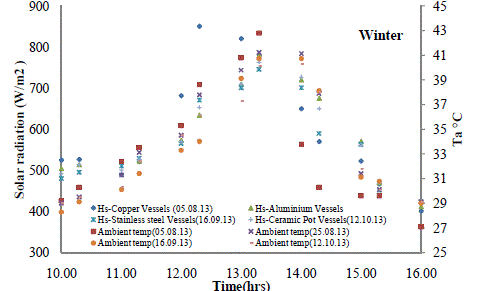 |
| Fig.3 variation of global solar radiation and temperature summer days (at Coimbatore) |
| The base temperature of the cooking vessels without load has been recorded to find the effective vessel for cooking. Observations of one of the typical days in winter and summer have been taken and discussed. It has been observed that the intensity of solar radiation and ambient temperature are comparable for all the working days in winter as well as in summer separately with different cooking vessels and observations have been given equal footage. Figure. 4 represents the variation of temperature of the base of the four cooking vessels with respect to time. The temperature of the base of the cooking vessels have been seen for about 80 minutes in winter. It is observed that, during the winter days, the temperature of the base of the cooking vessels are 80°C, 75°C, 72°C and 62°C for copper, aluminium, stainless steel and ceramic pot vessels. It is seen that the copper base vessel has shown higher temperature compared to the other vessels due to high thermal and low specific heat capacity of copper. Similarly in summer, the temperature of the base has been examined after 70 minutes and it is observed that the vessels have reached the temperature of 110°C (copper vessel), 94°C (aluminum vessel), 84°C (silver vessel) and 66°C (ceramic vessel). For all the vessels, the temperature of the base of the vessels has shown higher than that of winter days due to clear and sunny weather. This led to the conclusion that, copper vessel has significant impact on convecting thermal energy to the cooking fluid. |
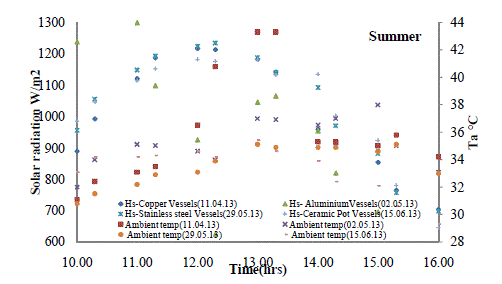 |
| Experiments have been proceeded with load of 1 kg of water in the four vessels and tested. The boiling point of water has been reached in 70, 80, 90, 100 minutes during summer and 80, 90, 100, 110 minutes for copper, aluminium, stainless steel and ceramic pot vessel during winter respectively. The cooker with load confirmed the effectiveness of copper vessel that dominates the other vessels for cooking. Hence in the proposed DESC, copper base vessels can be used effectively for cooking in short interval of time and number of times during the working hours of the day in both summer and winter days. |
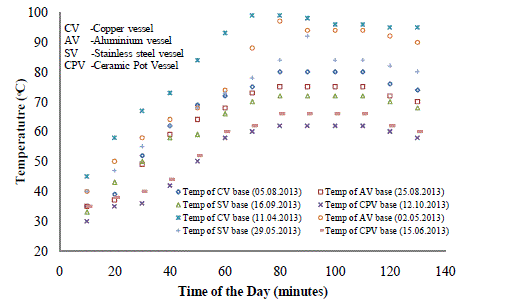 |
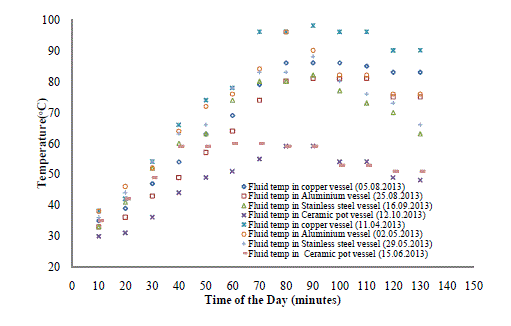 |
| Energy and exergy assessment of the proposed cooker has been studied by finding the energy and exergy efficiency with 1/2 kg of water in copper vessel during summer and winter. Figures. 7 and 8 represents the energy and exergy efficiency of the cooker during summer and winter along with the intensity of solar radiation. From Fig. 7, it has been observed that the average energy efficiency in summer and winter was found to be 16.793% and 25.7462%. The average energy efficiency during summer is lesser than in winter due to the faster convection of large amount of energy to the cooking fluid. In winter, the efficiency is higher due to decreased intensity of solar radiation. Since the input energy in winter is lesser than summer, the energy efficiency has shown higher value. |
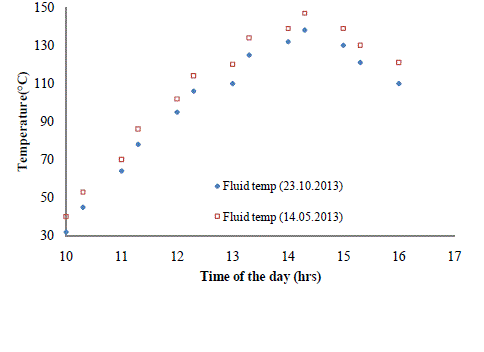 |
| From Figure.8, it is clear that the average exergy efficiency in winter is slightly higher than in winter. This is due to the maximum degradation of energy in summer than in winter. It has been found that the average exergy efficiency in summer and winter are 1.127 and 1.2872%. The variation of instantaneous energy and exergy efficiency of the proposed DESC during summer and winter has been presented in Table. 1 and Table 2. From the tables. 1 and 2, it has been observed that the instantaneous exergy efficiency during summer and winter is lesser than the instantaneous energy efficiency due to the degradation of energy into work by the proposed cooker throughout the working hours of the day. The assessment provides an optimistic hope for the utilization of the cooker in the climatic conditions of Coimbatore in a positive manner. |
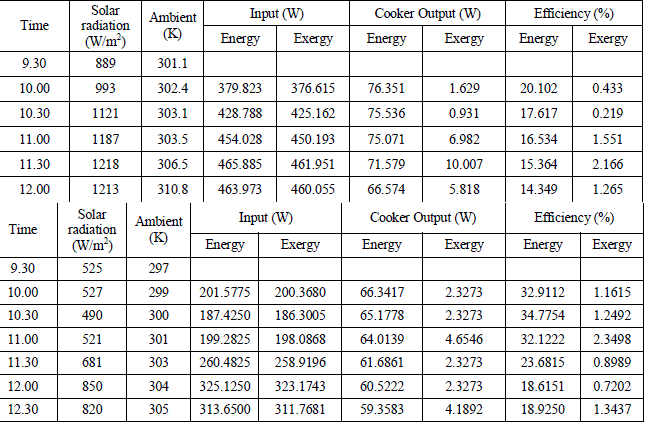 |
| Table: 2 |
| Performance of DESC with copper base vessels and mass of water in half kg in Winter seasons |
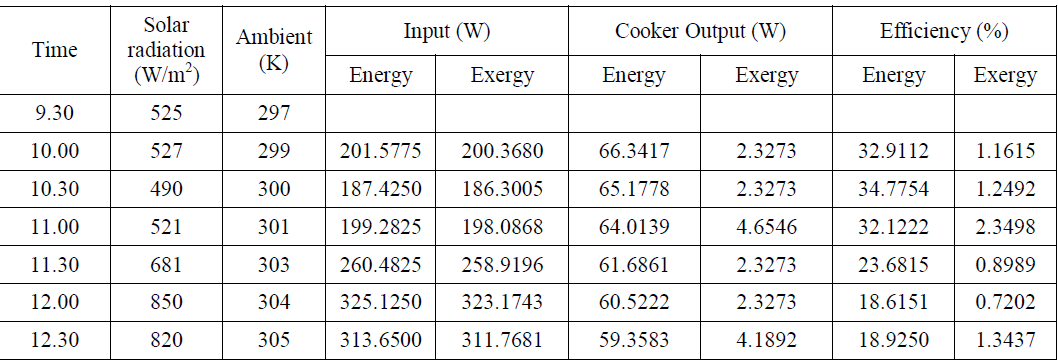 |
CONCLUSION |
| The following conclusions have been drawn from the experiment during summer and winter and are |
| (i) The double exposure solar cooker is found to be efficient in both summer and winter |
| (ii) Copper vessel has significant impact on the performance of the cooker |
| (iii) Energy and exergy assessment led to the definite suitability of the cooker in the climatic conditions of Coimbatore, Tamilnadu, India |
| (iv) Cooker can be used for number of times in a day without much problem |
| (v) Food cooked using the cooker is found to be dust-free and highly nutritious |
| (vi) The cooker can be commercialized with an optimistic hope to reduce the consumption of conventional sources for cooking |
| (vi) Design optimization can be done for the cooker for large scale installations |
Nomenclature |
 |
| It Transmitted solar radiation inside the cooker |
| Hs Total solar radiation on horizontal surface |
References |
|